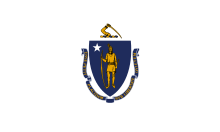
The 28th Massachusetts Infantry regiment was the second primarily Irish American volunteer infantry regiment recruited in Massachusetts for service in the American Civil War. The regiment's motto was Faugh a Ballagh
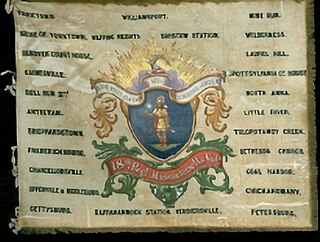
The 18th Massachusetts Infantry Regiment was a Union regiment that fought in the American Civil War.
The 62nd Massachusetts Volunteer Infantry Regiment was an infantry regiment being raised to serve in the Union Army during the American Civil War. The war ended before the unit was complete.
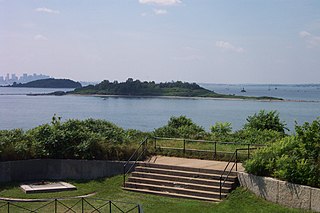
The Unattached Companies of Massachusetts Volunteer Militia were units of infantry raised for the defenses of the eastern coast of Massachusetts during the American Civil War. Twenty-six companies were mustered into the Union Army during 1864-1865, several of them reorganizing for additional terms of service.
The 61st Regiment Massachusetts Volunteer Infantry was an infantry regiment raised for one year's service in the Union Army during the American Civil War from 1864 to 1865.

The 51st Regiment Massachusetts Volunteer Infantry was a regiment of infantry that served in the Union Army during the American Civil War. The regiment was assigned to Major General John G. Foster's Department of North Carolina, later designated as the XVIII Corps. While based in New Bern, North Carolina, the 51st Massachusetts took part in several expeditions involving numerous units from Foster's command and were engaged in the Battle of Kinston, the Battle of White Hall and the Battle of Goldsborough Bridge, among other engagements.

Arthur Forrester Devereux was a captain in the Massachusetts Volunteer Militia prior to the Civil War and a colonel in the Union Army during the Civil War. He is notable for his expertise and proficiency in the instruction of military drill. During the Battle of Gettysburg, the 19th Massachusetts Infantry, under his command, played an important role in filling a breach in the Union lines during Pickett's Charge. After his active service had concluded, Devereux was awarded the honorary rank of brevet brigadier general, United States Volunteers, by appointment of President Andrew Johnson on February 21, 1866, to rank from March 13, 1865, and confirmation by the U.S. Senate on April 10, 1866.

The 7th Regiment Massachusetts Volunteer Infantry was an infantry regiment in the Union army during the American Civil War. It was formed on June 15, 1861, in Taunton. Its original commander was Colonel Darius N. Couch who would eventually be promoted to command the II Corps of the Army of the Potomac and, after that, the Department of the Susquehanna.

The 11th Massachusetts Infantry Regiment was an infantry regiment in the Union Army during the American Civil War. Organized in Boston in May 1861, the 11th Massachusetts Infantry was made up mostly of men from Boston, but also from Charlestown and Dorchester. The leading force behind the formation of the regiment was its first colonel, George Clark Jr., who had been an officer in the Massachusetts state militia. The regiment was known as the "Boston Volunteers."

Ansel Dyer Wass was a Union Army officer during the American Civil War. Wass was born in Addison, Maine on November 12, 1832.

The 19th Regiment Massachusetts Volunteer Infantry was an infantry regiment that served in the Union Army during the American Civil War.
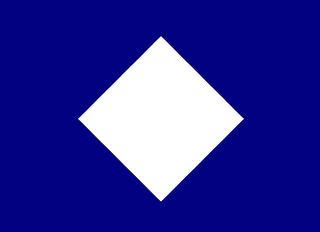
The 16th Massachusetts was an infantry regiment that served in the Union Army during the American Civil War formed of volunteers from the Commonwealth of Massachusetts.

The 17th Massachusetts was an infantry regiment that served in the Union Army during the American Civil War.
The 40th Regiment, Massachusetts Volunteer Infantry Regiment was a three-year infantry regiment of the Union Army that served in the Department of Virginia and North Carolina, the Army of the Potomac, and the Department of the South during the American Civil War.

The 3rd Massachusetts Volunteer Militia Regiment was a peacetime regiment of infantry that was activated for federal service in the Union Army for two separate tours during the American Civil War. The regiment consisted of companies from Plymouth and Bristol Counties.

The 5th Regiment Massachusetts Volunteer Militia was a peacetime infantry regiment that was activated for federal service in the Union army for three separate tours during the American Civil War. In the years immediately preceding the war and during its first term of service, the regiment consisted primarily of companies from Essex County as well as Boston and Charlestown.
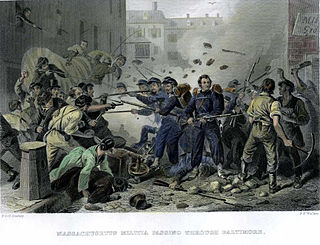
The 6th Regiment Massachusetts Volunteer Militia was a peacetime infantry regiment that was activated for federal service in the Union army for three separate terms during the American Civil War (1861-1865). The regiment gained notoriety as the first unit in the Union Army to suffer fatal casualties in action during the Civil War in the Baltimore Riot and the first militia unit to arrive in Washington D.C., in response to President Abraham Lincoln's initial call for 75,000 troops. Private Luther C. Ladd of the 6th Massachusetts is often referred to as the first Union soldier killed in action during the war.

The 43rd Regiment Massachusetts Volunteer Infantry was a regiment of infantry that served in the Union Army during the American Civil War. The unit was first formed in September 1862 in response to President Abraham Lincoln's call for 300,000 men to serve for nine months. The nucleus of the regiment was the Second Battalion Massachusetts Volunteer Militia, a unit dating to 1798 known as the Boston Light Infantry and nicknamed the "Tigers." The 43rd Massachusetts therefore became known as the "Tiger Regiment."

The 3rd Battalion Massachusetts Rifles was an infantry unit created at the start of the American Civil War and activated for federal service in the Union army for a term of ninety days. It consisted of three companies of prewar militia and one newly recruited company together organized under the command of Major Charles Devens. The term "rifles" was a designation frequently given to antebellum militia companies which trained in the use of rifled muskets—a relatively new innovation at the time—as opposed to smoothbore muskets. Only minor differences in training and tactics differentiated such units from a typical infantry company of the time. During the 1840s, "rifle" companies were often expected to train and serve as skirmishers in open order, however by the Civil War, United States army tactics manuals made no distinction between a company of "rifles" and a typical infantry company.

The 4th Regiment Massachusetts Volunteer Militia, sometimes known as the 4th Massachusetts Infantry, was a peacetime regiment of infantry that was activated for federal service in the Union Army for two separate tours during the American Civil War. Most of the companies were from Norfolk County, Massachusetts. The regiment had its headquarters in Quincy, Massachusetts.
